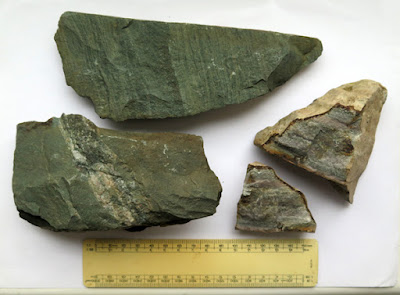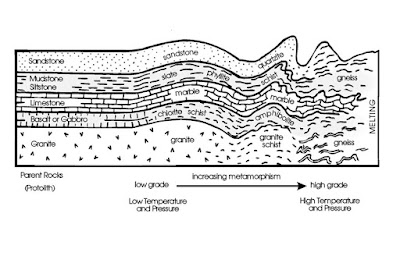 |
| A thin section of staurolite viewed with crossed polars |
My surprisingly busy year of travel in 2022 came to an end with my day out to Bolsterstone on 23rd November and, after spending the best part of the next 2 months writing this Language of Stone Blog, my next day out of any note was to attend the Sheffield U3A Geology Group indoor meeting on the 15th of January 2024.
 |
| The introduction to my illustrated talk |
Our theme for this year was the basic classification of rocks and, after Paul and Hilary - who had worked as geography teachers – had taken it upon themselves to talk on sedimentary and igneous rocks respectively, I was delegated to talk about metamorphic rocks.
As an undergraduate geologist at Nottingham University, metamorphic petrology was just one of our compulsory modules and a 2 week field trip based at Castle Sween in Argyll and Bute was spent studying various Dalradian rocks, but I don't remember too much about it.
 |
| The geology around Keswick |
I also spent 6 weeks mapping the regionally metamorphosed andesitic lavas and tuffs of the Borrowdale Volcanic Group to the south of Keswick and, when helping a girlfriend with her fieldwork at Newborough on Anglesey, encountered the regionally metamorphosed pillow lava at Llandwyn Island – part of the Mona Complex, which is Neoproterozoic to Cambrian in age.
On that occasion, I collected a large metaquartzite cobble from the beach, which contains a vein of breccia and is presumably derived from the Mona Complex. A few years later, during a 2 week driving holiday in my MG Midget, which reached as far as the whisky country and the Great Glen, I picked up another piece of metaquartzite, which clearly shows alternate sandy and clay rich beds.
As a geologist, I have barely scratched the surface of the subject and, in the 35 years since, my only close encounters with metamorphic rocks in situ have been the schistose rocks from the Cordillera Bética at the Roman theatre in Cartagena, Palaeozoic basement rocks in the Catalan Coastal Range at Parc Güell in Barcelona and Connemara marble at the end of a 7 month spell working for the Geological Survey of Ireland.
With the group limiting their field trips to a 2 hour drive from Sheffield, except for the Precambrian tuffs and granites in Charnwood Forest, the geology that they have encountered consists of a wide range of sedimentary rocks from the Lower Carboniferous to the Triassic, with the occasional basalt and tuff seen in the Peak District National Park.
The working background and level of education of the various members is quite varied, but with a bit of time and having explanations given out in the field, the concepts of bedding, jointing, folds and faults, as well as others relating to the geomorphology of the various landforms encountered, are generally understood; however, with the application of heat and pressure during metamorphism, the changes in mineralogy and textures introduces a whole new vocabulary and processes that aren't always easy to follow.
To explain these without reference to specimens or photographs of rock outcrops, based on my own professional experience – as I would use for my specialist subject of building stone - is quite a task, especially when only allowed an hour. As I discovered when referring to old text books and undertaking online research, appropriate illustrations and diagrams were actually surprisingly difficult to find.
When meeting up with Paul and Hilary to finalise plans for the day, having spent a considerable amount of time to try and simplify a very complex subject, I was not heartened when they complained that they did not understand very many words in my PowerPoint presentation – but that just illustrates the nature of metamorphic geology!
Being satisfied that I had pitched my talk at the right level, I went home and continued to prepare my talk using the resources that I had to hand, which included a few photomicrographs that I had taken at Sheffield University – when preparing an idea for a display at Clifton Park Museum that I subsequently developed for my Glowing Edges Designs artwork.
On the day, having exceeded my allotted hour, I started to get various looks and gestures from Paul at the back of the conference room to tell me that my time was up; however, having already drawn the short straw and spent an inordinate amount of time preparing this, I was determined to complete my talk.
Given that I had not studied the subject for more than 40 years, I was quite pleased with my effort and the feedback from the group seemed to be very positive. If asked to do this again, I would prefer to have more time and combine it with a practical session and, in the absence of rock specimens, I would make the effort to find more examples of building or decorative stone, such as the volcanic green slate plaques in the Sheffield Peace Gardens.











No comments:
Post a Comment